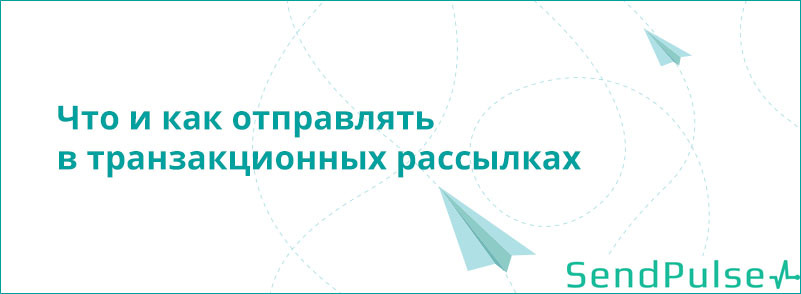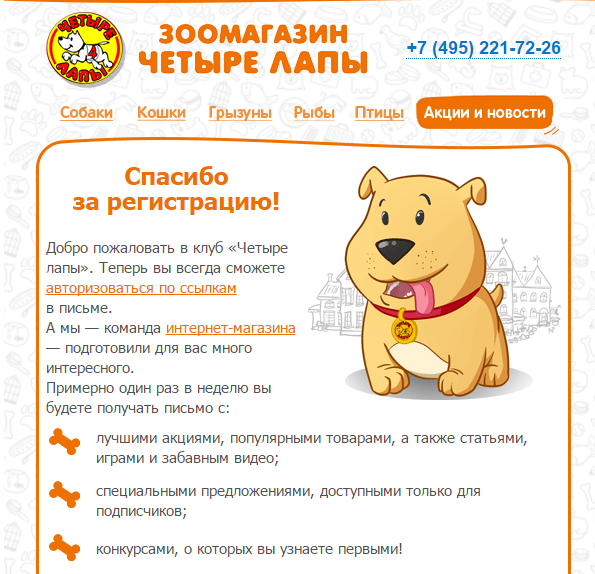What and how to send in transactional letters
- Tutorial

In email marketing, there are two types of mailings:
- mass mailings - when letters are sent to a group of subscribers;
- Transactional mailing - automatic delivery of letters to a specific subscriber.
The basis of the transactional mailing is information about events from the user's life or actions: confirmation of registration on a particular site, confirmation of a change in the tariff plan, making purchases in online stores, etc.
Transactional letters are sent if a "transaction" is committed - that is, action : a person registered on the site, and after a short time received an email confirmation of this event.
In this case, the letter was sent and addressed to him personally, because it is associated with actions.
Transactional newsletters are a way to retain a customer and a chance to increase engagement.
Today, little attention is paid to this type of mailing list. According to the results of L2 research , only 20% of companies send transactional letters. It's a pity. Such letters easily combine useful information with advertising.
In the first place in transactional messages, put the relevant context, and after it it is advisable to place marketing information or advertising. However, remember that the subject line of such a letter corresponds to the main content, not the advertisement.
International startup businessman and investor Dave McClure has created a model for the operation of transactional mailings. The model, which is based on the life cycle of users, makes it possible to answer the main question: "How to get the most out of emails?"
Dave's model identifies 5 stages in the development of a transactional mailing system:
- Acquisition - the emergence of new customers. Interested, convince a potential user to go to the desired site.
- Activation - new customers show interest in the product or information and use it - registration on the site, subscription, account creation, etc.
- Retention - customers are interested in the proposed product or information, regularly review news, advertisements and are ready to make a purchase.
- Recommendation - customers are so pleased with the services and information that they recommend them to their friends either directly or by sending them links.
- Income - customers get the benefit, and you get the money.
Stage of the acquisition. Greeting letter
The first thing that a person who decides to subscribe to this or that newsletter will receive and leaving his email address is a greeting letter.

When writing welcome letters, they make two common mistakes:
- Underestimate the importance of greeting letters and formally approach to writing it.
- Press on the client. Too strong “desire” to continue communication and force the client to use the services of the company.
Stage of activation. Adaptation letter
So, a new client has registered on the site, looked at the content - took the first step, and you should definitely pay attention to it. Response letter is an important step in email marketing relationships. But, before sending a letter to the client, ask yourself one question: “What do I already know about this person?”
- Did the client open the greeting letter?
- Did the client read the information in the letter and follow the links?
- How interesting is the site content to the client?
- What is interesting to him?
Answers to these questions, plus experience in dealing with existing customers will help to correctly compose the tactics of email newsletters. Create an individual letter, use the information that you already know about your clients in general and especially about each client.

Customer Retention Step
You have an active user. This is where the fun begins. You have already passed the awkward stage of dating, and both sides are pleased with the result. We begin to communicate in a conversational tone. But be careful not to go too far. At this stage, give some advice to customers, send out advertisements and news. The main thing is to retain users, interest them again, tell them relevant and interesting information.
Talk about popular content on the site over the past week. If the content does not differ in brightness and novelty, then you have to show creativity in order to interest users. This is the heart of a successful transactional strategy. Remember which letters have already been sent to customers, and which of them have received the best statistics.
Case study:Facebook makes extensive use of the 15 friends tactic. If the user adds 15 friends, then he will most likely become a lifetime user of the Facebook network. Think about it and remember the last time you received a message that someone confirmed your friendship. If you are an active user, such messages are sent automatically.

The main trick in the customer retention phase is to find out how often users want to hear you. You do not want them to forget about you, but you also do not want to bother them. Customers who want to unsubscribe from newsletters do not need you.
If the risks of losing a client are great, then use a letter such as "Congratulations, you won a discount!". There is nothing shameful in such a reception. But this should not be done often and always carefully.
The stage of recommendations to friends
It's great when the user is active and recommends the site or service to friends and relatives. Thus, the customer network is expanding, and everyone benefits. But this is not easy to achieve, because the client must be incredibly satisfied with the services in order to recommend them to someone else. Therefore, encourage active users to recommend the site to other potential users. It is also important that you have a group of people who can test products, conduct research, etc.

The stage of obtaining the result.
Marketers spend a lot of time talking about the profitability of marketing investments. However, among such conversations, the main thing is forgotten: the assessment of the client’s life cycle. The developed tactics of email newsletters are triggered at the last stage. When everything is already on an established path.
In general, the following types of transactional letters can be distinguished:
- order confirmation. This type of letter is sent to the recipient after completing one or another order (purchase, registration, connection of a tariff plan, etc.).
- confirmation of the e-mail address. Such notifications come to the client after subscribing to any newsletter.
- receipt of payment.Notifications of this kind are sent after the service company has received payment for the order. Sometimes in such a letter there may be a link to download all sorts of digital products. For example, computer programs or e-books.
- notice of dispatch of goods. Also, such a letter often contains useful information about the delivery of goods, the possibility of return, etc.
- warnings are system notifications about changes in the operation of a site or online store, changes in tariff plans, etc.
- behavioral triggers- mailing of letters is made depending on the actions of the client on the site. This may be a greeting of a new client after registration, special offers, promotions, reminders of incomplete purchases, offers of goods similar to those that the client viewed on the site, etc.
- triggers associated with a specific date . Most often, these can be birthday greetings, which are automatically sent to customers, given their date of birth.
In conclusion, it should be noted that email newsletters are certainly good. But do not forget about the most important thing. It is not enough just to write a beautiful and stylish letter, it is necessary to use it to develop a system of interaction with users, when one side will provide quality services, and the other side will tell other potential users about you as a thank you.
If you have any questions about transactional mailings - write in the comments. I will be happy to answer them.
 Konstantin Makarov, CEO of SendPulse Successful Newsletter Service
Konstantin Makarov, CEO of SendPulse Successful Newsletter Service